Quincy Adams Gillmore
Quincy Adams Gillmore (born February 25, 1825 in Lorain (Ohio) (formerly Black River), † April 11, 1888 in Brooklyn , New York ) was a brigadier general of the Northern States and during the Civil War leader of an engineer corps on the coasts of South Carolina and Virginia . His technical knowledge of siege and fortress wars as well as artillery made him known during the American Civil War .
Life
Early time
Gillmore was named after President John Quincy Adams by his parents and graduated from West Point Military Academy in 1849 . Gillmore was assigned to the Corps of Engineers and worked in Virginia on the Hampton Roads coastal fortifications .
In the civil war
At the beginning of the Civil War, Gillmore served on General Thomas West Sherman's staff in 1861 and accompanied him in the capture of Port Royal (November 3-7, 1861). Then Gillmore was given an independent command: he operated the siege of Fort Pulaski , a coastal fortress on Tybee Island , near Savannah . Gillmore first used the heavy artillery en masse to decorate a fortress at a great distance . The fort surrendered after nearly 5,000 grenades wore its walls. Gillmore's triumph against Fort Pulaski earned him not only the rank of brigadier general, but also in 1862 the command of the Department of the South, which also included South Carolina. Gillmore deployed both army and navy forces in close collaboration to attack Charleston in 1863. Gillmore commanded the Union Army's land section on Morris Island . The first frontal attacks by the infantry against the batteries of Fort Wagner failed to displace the Confederates, for which the 54th Massachusetts, a regiment of African-Americans led by white NCOs as required by law, had to pay thousands of victims (11th and 18th centuries). July 1863). Recognizing the futility of further attacks, the Union dug trenches and pulled the heavy artillery closer to the Confederate positions, causing the fire to rock the Wagner battery. The Morris Island campaign heralded the horrors of modern wars such as World War I , where aerial reconnaissance using balloons, calcium lights allowed night bombing, and wire barriers and automatic weapons such as the Billinghurst-Requa cannon were used. In early September 1863, the Confederates evacuated Morris Island. But this stalled the dynamism of the campaign, because the Union did not use Morris Island as a springboard to conquer the port of Charleston .
In February 1864, Gillmore sent troops to Florida under General Truman Seymour . Despite orders from Gillmore not to go inland, General Seymour advanced towards Tallahassee , the capital, and carried out the Battle of Olustee , which resulted in the Union's defeat. Gillmore, meanwhile, used artillery on Morris Island to bomb Fort Sumter and Charleston, which sparked the protest of Confederate General Beauregard . Gillmore received the dubious award of being one of the first military commanders to direct massive artillery fire at a civilian center.
Corps commander
In May 1864 the Siege Corps of General Gillmore was shipped to the Army of the James in Virginia and fought under General Benjamin F. Butler in the failed Hundred Bermuda Operation. You participated in the Bermuda Hundred Operation and starred in the disastrous action of Drewry's Bluff. Gillmore had openly argued with his supervisor, Benjamin F. Butler, about the guilt of this defeat and even asked for a transfer to Washington , DC. In July 1864, Gillmore helped organize a force of 20,000 invalids and recruits to protect the capital from a threat from 10,000 Confederates under Jubal A. Early , who had reached Washington's outer defenses. During this period, reinforcements were moved east from the Gulf Coast and Gillmore was given command of the XIX. Corps, which was quickly diverted to defend the capital after the Battle of Fort Stevens (July 11-12, 1864). In 1865 the corps was brought to Savannah by the Navy to support General WT Shermann .
After the war
Gillmore returned to New York City after the war. There he worked as a civil civil engineer and authored several books and articles on new building materials, including cement. Gillmore was a member of the city's Rapid Transit Commission, which designed elevators and public transportation, and led efforts to improve New York's port and coastal defenses. Gillmore was also involved in rebuilding fortifications along the Atlantic coast, including some that he himself helped destroy during the war.
After Gillmore's first wife died, in 1876 he married the widow of the former Confederate General Braxton Bragg , who had died in New Orleans. General Gillmore died in New York at the age of 63 and was buried in West Point Cemetery. His son and grandson were both called Quincy Gillmore and were also generals in the US Army.
Web links
| personal data | |
|---|---|
| SURNAME | Gillmore, Quincy Adams |
| BRIEF DESCRIPTION | US Army Pioneer General |
| DATE OF BIRTH | February 25, 1825 |
| PLACE OF BIRTH | Lorain (Ohio) |
| DATE OF DEATH | April 11, 1888 |
| Place of death | Brooklyn , New York |
